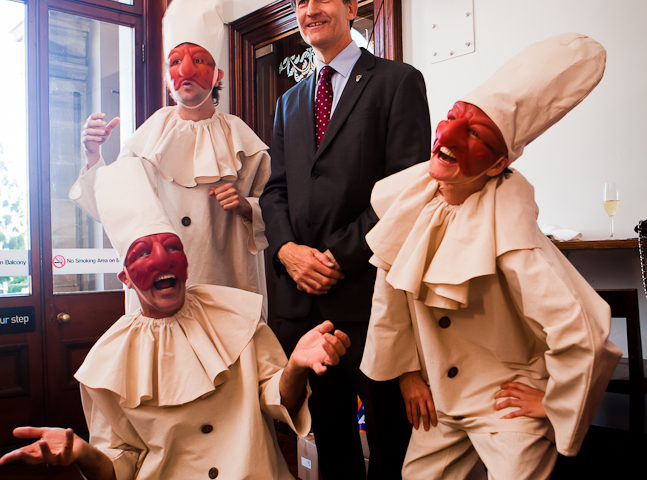THE PULCINELLAS

The Pulcinellas – A Commedia dell’Arte Explosion of Laughter and Mayhem!
The Pulcinellas are a mischievous trio of Commedia dell’Arte performers who burst onto the scene with explosive energy, timeless humour, and boundless theatricality. Drawing from the rich 16th-century Italian tradition of Commedia dell’Arte, this dynamic ensemble celebrates the universal language of physical comedy, mask work, and improvisation — igniting imagination, joy, and curiosity in audiences of all ages.
At the heart of the trio is Pulcinella — the cheeky trickster with a beak-nosed mask, humped back, and razor-sharp wit. He’s joined by two fellow buffoons, each with their own idiosyncratic physicalities, voices, and comic archetypes. Together, they weave tightly choreographed chaos through slapstick routines, physical gags, spontaneous improvisation, live sound effects, and hilarious interactions with the audience.
Every performance is a whirlwind of:
- Stylised movement and characterisation
- Classic lazzi (comic routines)
- Rapid-fire improvisation
- Masked storytelling
- Exaggerated status-play and satire
- Ridiculous scenarios with clever social commentary
Perfect for festivals, school incursions, public events, and theatre programs, The Pulcinellas celebrate the enduring power of live theatre to connect people through laughter, shared experience, and the sheer delight of seeing humans at their most absurdly honest.
Australian Curriculum Connections – Grades P–12
The Pulcinellas provides rich cross-curricular links and immersive learning opportunities across the strands of Drama, English, Humanities, and General Capabilities (Critical and Creative Thinking, Personal and Social Capability, Intercultural Understanding)
P – YEAR 2
Drama (ACARA):
- Explore role and dramatic action in dramatic play, improvisation and process drama.
➤ Students explore simple Commedia characters like the servant or master and learn to express emotions through body, gesture, and masks. - Use voice, facial expression, movement and space to imagine and establish role and situation.
➤ Learners experiment with exaggerated movements and slapstick with the trio, igniting imagination and storytelling.
General Capabilities:
- Personal & Social Capability: Cooperation in group drama games and confidence building.
- Critical & Creative Thinking: Improvisation fosters divergent thinking and creative risk-taking.
YEARS 3–6
Drama:
- Develop skills and techniques of voice and movement to create character, mood and atmosphere.
➤ Students analyse and perform stock characters like Arlecchino and Pantalone using mask, posture, and voice. - Rehearse and perform devised and scripted drama that develops narrative and uses performance styles and conventions.
➤ Students co-create lazzi and physical comedy routines in the Commedia style.
English:
- Understand how language can be used to express humour (e.g., puns, irony, exaggeration).
➤ Pulcinella’s antics provide perfect examples of verbal and non-verbal humour.
Humanities (HASS):
- Explore cultural traditions and stories from the past.
➤ Students gain historical context around Italian street theatre and its influence on modern comedy.
General Capabilities:
- Intercultural Understanding: Learn about Italian performance heritage.
- Ethical Understanding: Satirical content prompts discussion on fairness, justice, and power.
YEARS 7–10
Drama:
- Analyse and explore the elements of drama to shape character and performance.
➤ Students study stock characters (Zanni, Capitano, Dottore) and mask technique with live demonstrations from the trio. - Practise and refine the expressive capacity of voice and movement to communicate ideas and dramatic meaning.
➤ Students engage in workshops using physical theatre conventions, improvisation, and mask performance. - Evaluate how the elements of drama and conventions are manipulated to communicate meaning.
➤ Post-performance Q&As invite analysis of Commedia’s themes (power, love, greed, deception) through satire and status play.
English:
- Compare texts including media and performance texts, analysing how language, structure, and visual features influence audience interpretation.
➤ Students explore narrative structures and character archetypes from Commedia in relation to modern comedy (e.g., Mr. Bean, The Simpsons, Modern Family).
General Capabilities:
- Critical & Creative Thinking: Improvisation builds adaptability and problem-solving.
- Literacy: Understanding satire, parody, and narrative structure through physical storytelling.
SENIOR YEARS 11–12 (Drama and Arts in Practice – QLD Context)
Drama:
- Evaluate the impact of traditional and contemporary drama forms on audiences and practitioners.
➤ The Pulcinellas offers an authentic example of traditional masked theatre that can be directly linked to assessment tasks on historical performance forms. - Create and refine dramatic meaning through the manipulation of dramatic languages (time, space, symbol, mood, movement).
➤ Senior students gain access to artist-led masterclasses on mask work, non-verbal communication, and ensemble performance. - Investigate physical theatre and world theatre traditions.
➤ Commedia dell’Arte as a key movement in global theatre history, with connections to Lecoq, clowning, vaudeville, and modern comedy.
General Capabilities:
- Personal and Social Capability: Leadership in ensemble creation and performance.
- Ethical Understanding: Deeper reflection on satire, identity, and social dynamics.
Optional Inclusions for Schools
- Pre- or post-show workshops in physical comedy, or improvisation.